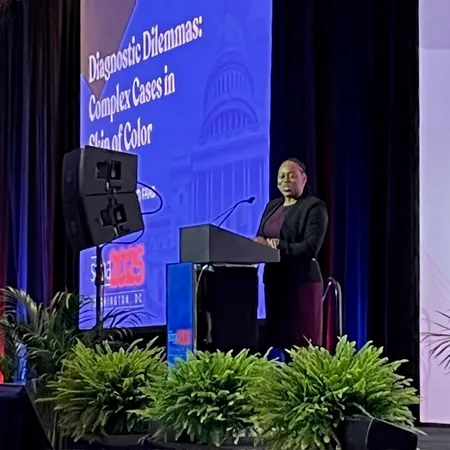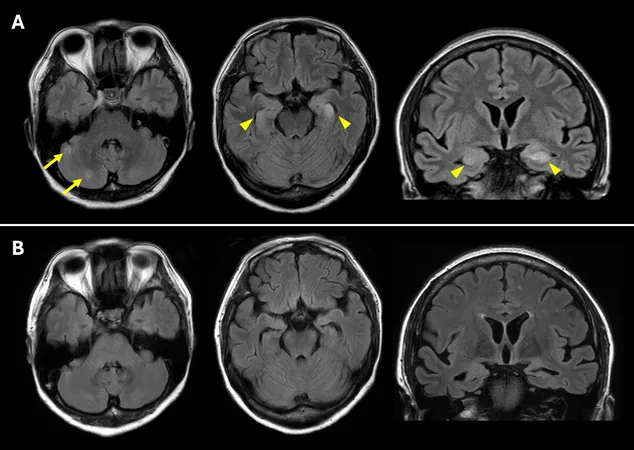
Unlocking Dermatology: Tackling Diagnostic Dilemmas in Skin of Color
2025-06-28
Author: Wei
Shining a Light on Complex Dermatology Cases
At the highly anticipated 2025 SDPA Annual Summer Dermatology Conference in Washington, DC, Dr. Ginette Okoye, a leading authority in dermatology for skin of color, delivered a riveting session titled 'Diagnostic Dilemmas: Complex Cases in Skin of Color.' This talk spotlighted the often-neglected complexities dermatologists face when treating patients with richly pigmented skin, a demographic where visual cues can easily be masked or misinterpreted.
Real-World Cases Unveiled
Dr. Okoye captivated the audience with a series of eye-opening case studies that revealed the diagnostic hurdles associated with inflammatory, pigmentary, infectious, and autoimmune conditions. Attendees were given vital insights into differentiating how common and rare dermatologic issues manifest in darker skin tones. She stressed that relying on standard diagnostic assumptions can result in delayed or even missed diagnoses.
The Case of a Young Patient
One particularly illustrative case involved an 11-year-old boy who presented with a six-month history of discoloration on his face, especially around his eyelids, and what his family described as a ‘rash’ on the back of his hands, previously misdiagnosed as eczema. Despite treatment with topical steroids, the rash did not improve, and the discoloration spread. Remarkably, the child experienced no itching and showed no systemic symptoms, but further examination revealed significant muscle weakness, prompting Dr. Okoye to reassess the diagnosis.
Critical Insights on Dermatomyositis
Initially considering conditions like seborrheic dermatitis and briefly dermatomyositis due to the eyelid and knuckle symptoms, Dr. Okoye focused on the muscle weakness. She explained that dermatomyositis often impacts proximal muscles, making tests for muscle strength essential. For this young boy, the diagnosis was ultimately juvenile dermatomyositis.
Cancer Risk Awareness
Dr. Okoye also shed light on the concerning fact that even though children are less affected, the risk of cancer in patients with dermatomyositis is four to five times higher than in the general population, particularly for those over 45. She emphasized the importance of screening at diagnosis and yearly follow-ups for at least five years.
A New Clinical Approach
During her session, Dr. Okoye underscored the significance of pattern recognition and thorough clinical assessments, advocating for prudent use of biopsies and laboratory tests to ensure accurate diagnoses. She addressed common diagnostic errors that disproportionately impact patients with skin of color and offered practical strategies to navigate these challenges.
Emphasizing Cultural Competence
Beyond clinical knowledge, Dr. Okoye stressed the necessity of culturally competent communication as a powerful tool to build trust and foster diagnostic accuracy within diverse populations. She encouraged attendees to adopt an inclusive diagnostic perspective, fine-tuning their clinical judgment to encompass both visual subtleties and a patient-centered approach.
Empowering Dermatology Practitioners
By the end of the session, dermatology PAs and other attendees left with a wealth of knowledge on diagnosing and managing complex dermatological cases in skin of color, equipped to enhance their practice and improve patient outcomes.
Stay Updated!
For more insights into these critical topics and updates from the 2025 SDPA Conference, stay tuned for our latest coverage.





 Brasil (PT)
Brasil (PT)
 Canada (EN)
Canada (EN)
 Chile (ES)
Chile (ES)
 Česko (CS)
Česko (CS)
 대한민국 (KO)
대한민국 (KO)
 España (ES)
España (ES)
 France (FR)
France (FR)
 Hong Kong (EN)
Hong Kong (EN)
 Italia (IT)
Italia (IT)
 日本 (JA)
日本 (JA)
 Magyarország (HU)
Magyarország (HU)
 Norge (NO)
Norge (NO)
 Polska (PL)
Polska (PL)
 Schweiz (DE)
Schweiz (DE)
 Singapore (EN)
Singapore (EN)
 Sverige (SV)
Sverige (SV)
 Suomi (FI)
Suomi (FI)
 Türkiye (TR)
Türkiye (TR)
 الإمارات العربية المتحدة (AR)
الإمارات العربية المتحدة (AR)